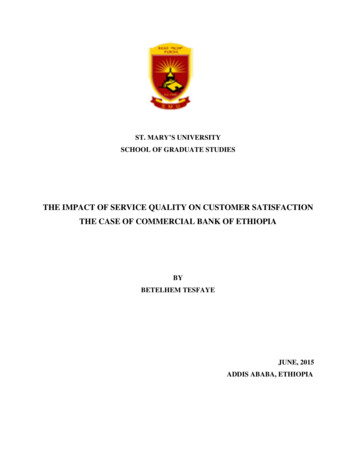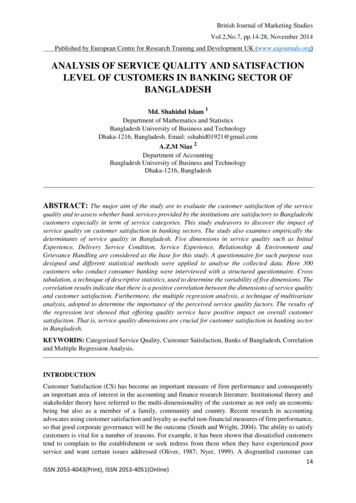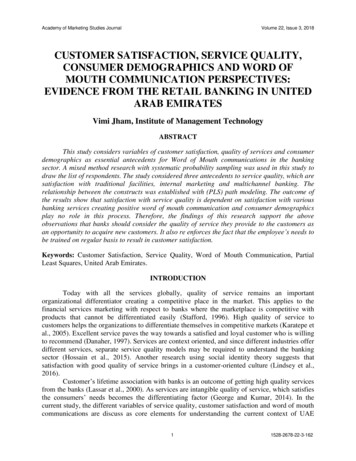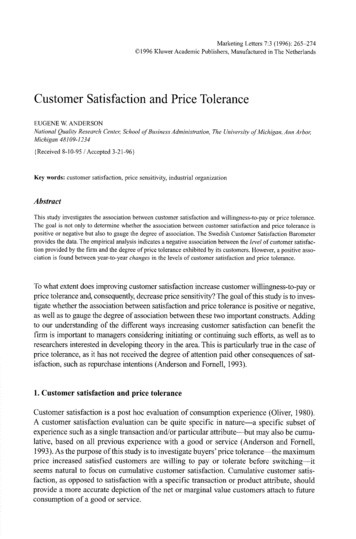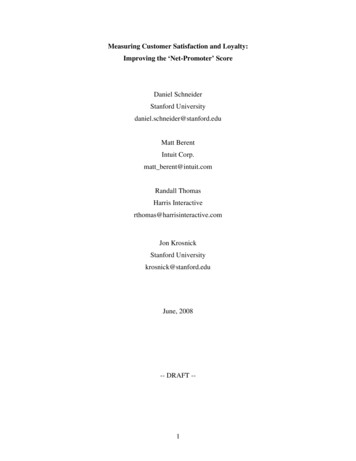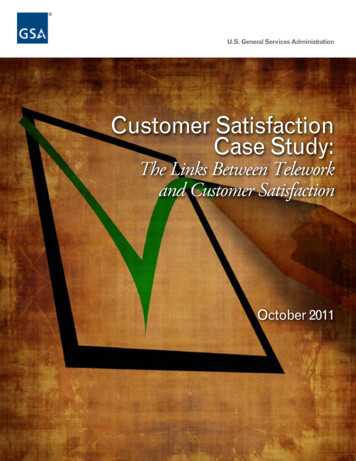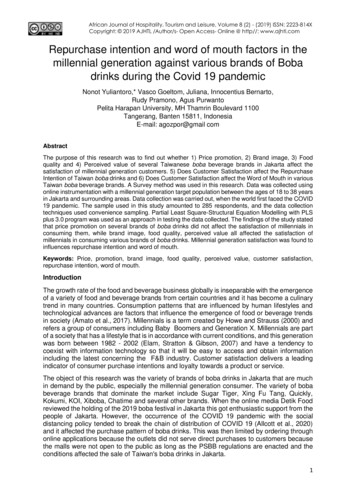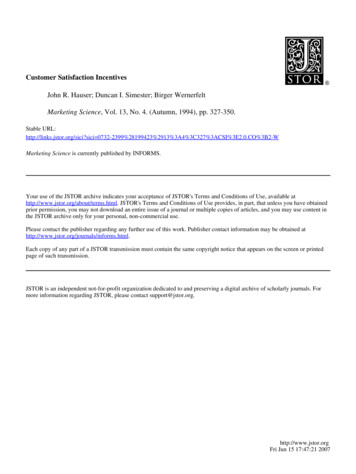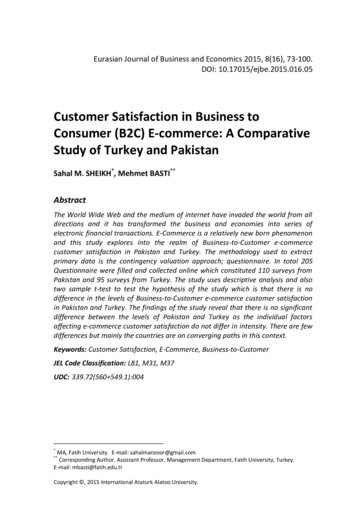
Transcription
Eurasian Journal of Business and Economics 2015, 8(16), 73-100.DOI: 10.17015/ejbe.2015.016.05Customer Satisfaction in Business toConsumer (B2C) E-commerce: A ComparativeStudy of Turkey and PakistanSahal M. SHEIKH*, Mehmet BASTI**AbstractThe World Wide Web and the medium of internet have invaded the world from alldirections and it has transformed the business and economies into series ofelectronic financial transactions. E-Commerce is a relatively new born phenomenonand this study explores into the realm of Business-to-Customer e-commercecustomer satisfaction in Pakistan and Turkey. The methodology used to extractprimary data is the contingency valuation approach; questionnaire. In total 205Questionnaire were filled and collected online which constituted 110 surveys fromPakistan and 95 surveys from Turkey. The study uses descriptive analysis and alsotwo sample t-test to test the hypothesis of the study which is that there is nodifference in the levels of Business-to-Customer e-commerce customer satisfactionin Pakistan and Turkey. The findings of the study reveal that there is no significantdifference between the levels of Pakistan and Turkey as the individual factorsaffecting e-commerce customer satisfaction do not differ in intensity. There are fewdifferences but mainly the countries are on converging paths in this context.Keywords: Customer Satisfaction, E-Commerce, Business-to-CustomerJEL Code Classification: L81, M31, M37UDC: 339.72(560 549.1):004*MA, Fatih University. E-mail: sahalmanzoor@gmail.comCorresponding Author. Assistant Professor, Management Department, Fatih University, Turkey.E-mail: mbasti@fatih.edu.tr**Copyright , 2015 International Ataturk Alatoo University.
Sahal M. SHEIKH & Mehmet BASTI1. IntroductionIn this consumer driven world economies it is very vital to comprehend the needsand wants of the potential consumers at large and also to probe into how satisfiedor happy they are from an organization’s product or service.Internet and the World Wide Web have amended the business competitions andtailored the Business-to-Consumer (B2C) relationship by introducing an innovativeretailing platform that provides for electronic one-on-one communication with thecustomers. The Internet possesses a capability of revolutionizing the businessconventional format and the customer service experience in many ways.The availability of uncountable products and their respective pricing information onthe internet lets customers to efficiently and easily become knowledgeable andproactive while shopping. It is of utmost importance according to previousliteratures to understand consumers and their utilization of the Internet for theorganizations in cyberspace businesses for sustainable success and growth. It isfound out that success in superior economic returns is attributed as a result ofsatisfied customers. The use of electronic technology in strategic ways can boost toimprove the overall customer to business relationship and can yield customersatisfaction which could serve as the basis of competition within the cyberspaceindustry and result innovative businesses methods for a firm (Hair & Keep, 1997).As per the report of Neilsen 2014, the internet penetration rates in Pakistan andTurkey are 15% and 43% respectively. These rates are very low compared todeveloped countries. The pre-requisite to e-commerce is the use and acceptance ofinternet and therefore with these low rates in both countries it is very vital toconduct researches and promote projects to make a way through for e-commerceindustry (Neilsen, 2014).2. The Dynamics of E-CommerceThis part of the study will introduce to key definitions of e-commerce and thehistory of its evolution. It will explain the general trends in business-to-customermodel and also will scrutiny other e-commerce models. The two countries underconsideration; Turkey and Pakistan, will also be investigated in context of ecommerce acceptance and the satisfaction of the customers achieved by B2Corganizations.2.1. The Evolving Definitions of E-Commerce and its Contrast to E-BusinessE-commerce is a phenomenon which has evolved during its origination and has setto have differing definition due to lack of consensus between many scholars.However there is unanimous agreement on a very fundamental level which is thate-commerce is set to be defined as commercial transactions that are conducted onthe Internet electronically. The problem arises when a concrete and comprehensivedefinition is poised by scholars (Ernst and Young, 2001).Page 74EJBE 2015, 8 (16)
Customer Satisfaction in B2C E-commerce: A Comparative Study of Turkey and PakistanOrganization for Economic Co-operation and Development (OECD) has given twodefinitions for e-commerce. One is narrow and concrete and one is descriptive andbroad. OECD broadly defines e-commerce as the sale or purchase of a product orservice, which could be among households, businesses, governments, individualconsumers, and other private or public companies, which is mediated throughcomputer networks. The important point to be noted in this definition is that goodsand services should be ordered over these mentioned computer online networks,but the payment and the final delivery can be carried out off or on-line. This broaddefinition includes the orders placed or received by customer on any online devicewhich can be used to make automated transactions like telephone, Electronic DataInterchange (EDI), Internet applications. On the other hand the narrower definitionby OECD was very similar to the above mentioned definition but it Excluded ordersplaced or received over the telephone, e-mail, or facsimile (OECD 1999a; OECD,2000a; OECD 2000b).According to the World Trade Organization (WTO), e-commerce is a phenomenonwhich realizes advertisement, production, distribution and sales of goods andservices via networks requiring telecommunication (Jewels et al, 2001).Chaffey (2009: 10), explained e-commerce is the exchange of electronic mediatedinformation between a firm and its external stakeholders. According to the authore-commerce has two paradigms which are buy-side e-commerce and sell-sidee-commerce. Buy side e-commerce is the interaction of organization and itssuppliers whereas sell-side e-commerce is the interaction between organizationand its customers.E-business and e-commerce are often intermingled ideas which have very thinborders to separate them. In e-business, Integrated Computerized Technology (ICT)is used to augment a business. There are three main processes which are enhancedin e-business namely firstly the production processes, which include productioncontrol processes and electronic linkages with the suppliers. Secondly customeraimed processes, which include marketing and promotional efforts, internet sales,customers’ payments and purchase order. Lastly, the internal managementprocesses which include the following programs: training, employee services,recruiting, internal communication, and video-conferencing. E-business is a termwhich would generally be found to be used in two main ways within anorganization. First it is used in a company’s strategy and operations and second it isused as an adjective to depict businesses that work online. (Chaffey, 2009: 13).After carefully understanding the different definitions of e-commerce and itsevolution over time we can give a generalized definition of e-commerce as a typeof business model, or fragment of a integrated business model, that allows the usedigital information and electronic communications processing technology totransform, create, and re invent relationships in business transactions for thepurpose of value creation among or between companies and between individualsand firms.EJBE 2015, 8 (16)Page 75
Sahal M. SHEIKH & Mehmet BASTI2.2. E-Commerce ModelsThe type of e-commerce model that should be employed depends on the partiesinvolved. E-commerce can be categorized into models depending on this matrixintersection that is mentioned below in Table 1. The main categories are B2C, B2Band C2C.Table 1. Matrix of Models of G2BConsumerB2CC2CG2CGovernmentB2GC2GG2GSource: The Economist, 26 Feb 2000The B2B model encompasses the transactions for purchasing, ordering, and foradministrative works between entities. B2B deals with trading goods, such as,professional services, business subscriptions, wholesale dealings andmanufacturing. It is also possible in the B2B model that a business may existbetween virtual firms, in which no party has any physical existence. In theseexamples, transactions are made only through the Internet (Chaffey, 2009).B2C model is described as any transaction or business that directly gives itsproducts to the end-consumers without any intermediately. B2C applies to anyorganization that indulges in selling its goods or services to the consumers over theInternet medium. These sites contain information regarding the goods and servicesoffered which stored in a database and is represented as online catalogues. TheB2C model is a broad model which also includes services travel services, onlinebanking, and online health services and information (Chaffey, 2009: 26; Yahia,2005; Malhotra & Singh, 2009).The C2C model is the transaction among consumers. In this model a consumersells/buys directly from another consumer. EBay and www.bazee.com are the twowidely used examples of online auction that provide a consumer a platform orarena to market and sell their products to other individuals. The individual whowants to sell a particular product should pay a fixed fee to the online platform tosell his/her products. On the other hand, the buyer can bid on the online auctionwithout paying any fee (Chaffey, 2009: 27; Moxon, 2001).2.3. The Notion of Business-to-Customer E-commerceThe worldwide expansion of the internet should be considered an integral part ofany country’s economy as the world has been revolutionized by technology and thenear future is e-commerce and e-business. The increasing confidence and trust inengaging in purchasing online are a source of initiatives to support thedevelopment of the digital global economy.Page 76EJBE 2015, 8 (16)
Customer Satisfaction in B2C E-commerce: A Comparative Study of Turkey and PakistanAccording to a report by the Interactive Media in Retail Group (IMRG, 2014), ecommerce statistics reveal a staggering rate at which this industry is developing asglobally, the sales of B2C e-commerce accounted for more than US 1.2 trilliondollars in 2013. Currently 40% of the worldwide internet users have boughtproducts online through mobiles, computers, tablets or other devices. This coinsthe total number of Internet users to be 3.5 billion from around 2.2 billion at theend of 2012 (UNCTAD 2014). Mobile commerce which is an extension of ecommerce to smart phones is another trend to study in terms of e-commerce factsand figures. In 2013, US mobile revenue amounted to approximately 38 billiondollars (Satista, 2015).The US claims to be the world’s single biggest e-commerce market according toIMRG (2014), followed by the United Kingdom and Japan. IMRG predicts thatgrowth rates in these countries will be nearly 10-15% annually. However, China’se-commerce sale is currently experiencing a growth of more than 130%. It issupposed to be only a matter of time, when this Asian giant becomes the largestsingle market in the world superseding US, UK and Japan.In terms of regions, Europe has the upper hand as it currently stands to be thelargest e-commerce market in the world. According to a report by (European MultiChannel and Online Trade Association, 2014), European B2C e-commerce salesposted an estimated 307 billion USD in 2011 which helped them to surpass theNorth America which accounted for 297 billion USD. IMRG (2014) also argued thatItaly, France, Russia, Turkey, Spain and Poland the fastest-growing markets inEuropean region.2.4. The History, Present and Future Trends of E-commerceThe birth of e-commerce dates back to the year 1960’s. E-commerce commencedwith the introduction of EDI, which facilitates information exchanges and maintainsrelations between companies via specifically designed group networks. EDI is notoutdated and is still being used in the Business-to-business model of e-commerce.The Internet and the World Wide Web have significantly contributed to thedevelopment of e-commerce (Meyer and Taylor, 2000).There are two pillars which instigated the progress of ecommerce since itsinception. The first is the advancements in information technology. The secondpillar is the global motto of globalized world and trade with market liberalizationpolicies. Furthermore, the need and want of economic interdependency amongcountries contributed to the formation of e-commerce (Korkmaz, 2002).To understand the trend of e-commerce it is very important to understand whatimpact has time on the level of e-commerce activity. Figure 1 displays the measuresof e-commerce activity over time. From recent years the technological acceptanceand growth rates have seen massive increases worldwide.EJBE 2015, 8 (16)Page 77
Sahal M. SHEIKH & Mehmet BASTIFigure 1. E-Commerce Level of Activity over TimeSource: OECD 2000cDetailed analysis of the world in Table 2 shows the internet penetration in the year2014. As we can observe that Pakistan has only 15% internet penetration whileTurkey has 57%. The highest internet penetration rates are observed in Denmarkand Finland with 97%.Table 2. Internet Penetration in 2014 Selected Countries in the outh KoreaUnited KingdomAustriaGermanyUnited StatesJapanFranceArgentinaInternet eyBrazilEgyptMexicoChinaIndiaPakistanInternet Source: Adapted by Neilsen, 2014To understand e-commerce the trends should be analyzed and studied in order tocomprehend the preferences of the customers over the world. Table 3 illustratesthe online purchase intention growth rates for the years 2011 to 2014. Thesefigures are the global average and show which fields or investment is more likely tobe made by online consumers when they engage in e-commerce transactions. Withthe world going global and the media playing its part to show the beauty of otherPage 78EJBE 2015, 8 (16)
Customer Satisfaction in B2C E-commerce: A Comparative Study of Turkey and Pakistancountries, e-commerce has been largely benefited with e-tourism which includesflight tickets, hotel reservations and event tickets. This can be seen from the Table3 as there are on the top of the list. However, the event tickets secure aconsolidated standing in this table which range from buying sports oriented ticketsfor matches to concerts tickets.Table 3. Popular E-Commerce Activities in 2011 and 2014CategoryEvent TicketsE-BooksComputers softwareTours and Hotel ReservationSporting GoodsToys and DollAirline Tickets and ReservationVideos, DVDs, Games and MusicComputer HardwareBaby SuppliesCar, Motorcycles and AccessoriesElectronic EquipmentCosmeticsGroceriesClothing, Accessories and ShoesMobile 46%33%Source: Adapted by Neilsen, 2014It is expected that by the year 2018 the estimated sales in US billion of dollars willbe 2,356 billion. This shows how huge this business platform is evolving to becomeand how all the enterprises worldwide are adopting e-commerce in their businessto facilitate and reach a wide variety of consumers.2.5. An Overview of Country Profile in The Light of B2C E-Commerce:Pakistan and TurkeyJennex et al. (2004) discussed in their study the need of appropriate infrastructurefor e-commerce in developing countries and the factors that turn developingsetting. This study concluded that e-commerce is filling the technology gapbetween out to be help the B2C enterprises to be successful in this naturalenvironmental the big and small enterprises and providing even playing field toevery new start-up to expand and grow particularly in developing countries.Seyal et al. (2004) researched the adoption rate of e-commerce and internetfacilities in small and medium enterprises (SMEs) in Pakistan. This study alsoprobed into the factors that affect the e-commerce adoption in SMEs in Pakistan.The research concluded that 80% of Pakistan’s SMEs have an internet account toprovide the basis of e-commerce. The study also found out that approximately 46%of the SMEs have “above average” adoption of e-commerce. In addition to this theEJBE 2015, 8 (16)Page 79
Sahal M. SHEIKH & Mehmet BASTIfactors that were examined included organizational culture, motivation to adopt ecommerce, technological availability, environmental concerns and managementsupport functions.Blythe (2006) discussed in his study the Electronic Transaction Ordinance (ETO)which was passed in the fiscal year 2002 in Pakistan concerning the e-commerceand e-government rules and regulations and their implementations. According tothe author ETO lays down the foundation for legal framework and validates theelectronic messages, records and signatures.Celik and Yilmaz (2011) researched in this article the acceptance of e-commerce bythe Turkish customers. They extended the Technological Acceptance Model (TAM)which is a very vital and significant modeling approach in the field of informationtechnology. The authors added perceived information quality, enjoyment, trust,service and system quality to the already existing TAM model. The findingssuggested that the variables added to the TAM model are significant and have anotable effect on acceptance of internet shopping. The article also highlights thebirth of e-commerce in Turkey in the year 1998.Kaynak et al. (2005) investigated the adoption of e-commerce in SMEs in Turkeyand also identified the significant factors that play a vital part in e-commerceadoption. The study collected data from 237 companies in Turkey which hadaccess to internet. It was found in the research that e-commerce positivelyinfluenced companies to adopt it because the net benefits outweighed theassociated net costs. According to the results of this article, e-commerce has anadvantage of external communication benefits to a B2C and also provides clustersof information that helps in product and market research development.3. Customer SatisfactionThe need for identification of problems associated with customer satisfaction in ecommerce and the methodology incorporated to evaluate it plays an integral rolein determining how to improve services provided by B2C organizations. Consumersatisfaction plays a pivotal role in the evaluation cycle of a consumption, shoppingor service or product usage and therefore is useful in extracting consumerresponses in the long-term (Gronroos, 1991). Both the business management andscientific literature realms have signaled a cohesive interest in fulfilling customerneeds to determine the purchase behavior.3.1. The Conceptualization of Customer Satisfaction and Prior StudiesThe first researches on customer satisfaction go back in time of Cardozo (1965) andHoward and Sheth (1969). These scholars investigated the influence and impact ofexpectations on satisfaction. These studies are known to be the origination ofscientific interest in the phenomenon satisfaction (Campo and Yague, 2009).Page 80EJBE 2015, 8 (16)
Customer Satisfaction in B2C E-commerce: A Comparative Study of Turkey and PakistanCustomer satisfaction is a gauge of performance of perceived organizationalproduct relative to a buyer’s expectations. If the product’s performance fails tomeet expectations of the consumer, then the customer is dissatisfied. Ifperformance copes up with the expectations, then the customer is satisfied. Ifperformance exceeds the levels of expectations, then the customer is said to behighly satisfied and delighted. Keeping customers satisfied serves as the bestcompetitive advantage against competitors. Customers are found loyal and areprepared to pay premium for a product. In addition to this they become excellentexternal marketers for the organization (Gupta et al., 2003).Gupta and Zeithaml (2006) proposed a theoretical framework for customersatisfaction in his article. According to the author there are five important variablesthat have a critical impact on the level of customer satisfaction. The researchconcluded that all of the five variables have a positive and significant impact on thecustomer satisfaction. The five factors that affect customer satisfaction are listed inFigure 2 below:Customer RelationshipManagementValue-added ServicesAvailability of ProductsCustomer SatisfacitonVariety OfferedAmbienceFigure 2. Factors Effecting Customer SatisfactionSource: Gupta and Zeithaml (2006)Giese and Cote (2000) and later adaptations by Moliner (2004) coined thatconsumer satisfaction is an approach based on two distinct criteria which areconceptual and referential criterions. Conceptual criterion explains satisfactionthrough types or processes of responses generated by consumers. Whereas, areferential criterion reflects the aspects of a situation in which a response mayoccur. It is very important to understand that these criterions are not necessarilymutually exclusive and that the main definitions in the previous studies mayhighlight complementary and different approaches. Figure 3 below illustratescustomer satisfaction described by the two criterions.Furthermore, recent customer satisfactions researches coincide with the initialresearches and indicate that expectation is the most direct determinant ofconsumer satisfaction. This is followed by an addition of perceived performance.EJBE 2015, 8 (16)Page 81
Sahal M. SHEIKH & Mehmet BASTIParker and Mathews, (2001) designed the value percept theory which describessatisfaction as an emotional response that is instigated by an evaluative cognitiveprocess. This is in a contradiction with earlier literature which defined satisfactionas an evaluative judgment (Oliver, 1997).Moreover, Swan and Combs (1976) were one of the first scholars to argue thatconsumer satisfaction is correlated with performance driven expectations anddissatisfaction occurs when performance does not meet the expectations and fallshort of it.Evaluation ProcessConceptualResponseEvaluation Process andAffective ResponseSatisfacitonReferencialSpecific TransactionCumulative CharacterFigure 3: Conceptual and Referential Criterion of SatisfactionSource: Adapted from Giese and Cote (2000) and Moliner (2004)The more conventional and traditional models define customer satisfactionimplicitly as a result of cognitive processes, while recent studies improving on theconceptual developments put forward that effective processes can also contributeto the estimation and definition of consumer satisfaction (Westbrook & Oliver,1991).3.2. E-Commerce Customer SatisfactionSingh (2002) underlined the importance of e-services to the B2C e-commercebusiness. According to the author this relationship has a positive impact on salesand customer relationship management. The findings of this research concludedthat services which the customers cherish include customer-queries answering asfast as possible, search support, transactions and order placement ease,convenient e-pay system, transparent and efficient e-transaction record and trustby e-assurance.Chen and Dubinsky (2003) analyzed that one of the key factors that affects B2C ecommerce is the information quality on the website. The customers always wantPage 82EJBE 2015, 8 (16)
Customer Satisfaction in B2C E-commerce: A Comparative Study of Turkey and Pakistanmore and more well detailed and importantly true information about the productsbeing displayed on the websites and therefore the information provided by the B2Corganization plays a critical role in customer satisfaction. Another factor related tothis is the comprehend ability of the information on the website. Gefen and Straub(2003) explained that customer trust is one of the critical factors that affectcustomer satisfaction. The authors explained trust as when a customer is doingtransaction with an organization; he/she will meet their expectations and will notindulge in any fraudulent or undesirable terms.Shankar et al. (2003), set out to research whether there is a profound difference inthe levels of customer satisfaction from online and offline purchases. They alsoinvestigated the customer loyalty differences from offline and online buyingmethods. The study found out that there is no mark difference between thecustomer satisfaction levels between the online and offline buying methodhowever the levels of loyalty shown by customers from online buying is greaterthan the offline buying customers. They also found out that the relationshipbetween customer loyalty and satisfaction is that of a reciprocal and that eachconcept positively reinforces the other.Zhang et al. (2006), came to a conclusion that the important and significant factorsthat affect e-commerce satisfaction include perceived convenience and securitythat the website offers and the customer’s own skills and experiences. Lin (2007)highlighted the importance and impact of website quality in terms of design andinformation provided on it for customer satisfaction in B2C e-commerce. Thisresearch also found out that the interactivity of the website plays an important rolein satisfying customers and making them loyal in regards to enticing them to repurchase from the same website. Other factors that are also important in thisregard are security and presence in social media.Bai et al. (2008) concluded that e-commerce consumers demand privacy when theyare engaged in a buying act with the company through internet for satisfaction. Theperceived privacy according to these writers meant that a consumer’s personalinformation should be kept safe and handled with care, and no third party shouldbe able to use or view the personal information of the consumers. The ability toretain and store the personal information and use it adequately is one of theprimary concerns of a customer when it comes to the phenomena of perceivedprivacy.Jianchi and Xiaohong (2009) stated that there are five variables that positivelyaffect customer satisfaction on e-commerce basis. These variables were the designof the website, the service that they provide to the user, the information qualitythat the website has, website intelligence and security. Eid (2011) researched thatconsumer loyalty in B2C e-commerce strongly and positively influenced bycustomer satisfaction. However the customer loyalty is weakly influenced byconsumer trust.EJBE 2015, 8 (16)Page 83
Sahal M. SHEIKH & Mehmet BASTIBrilliant and Achyar (2013) investigated that on a global level the sales of ecommerce and this study also concluded that the quality of information on an ecommerce website affects e-commerce satisfaction and also that e-commerce trustaffects the consumer loyalty of the B2C e-commerce.According to Subramanian et al. (2014), higher customer satisfaction in ecommerce can bring substantial benefits, such as repeat purchase, good word ofmouth, and profit increase.Jie et al. (2015) studied on product delivery service provider selection andcustomer satisfaction. According to authors findings substantive selective criteriashould include consideration of product delivery service providers’ hard and softinfrastructure. In addition they emphasize that flexibility is main criteria forstrengthen the relationship between e-retailers and delivery service providers tosatisfy the e-customers.3.3. Important Studies on E-Commerce and Customer Satisfaction inPakistan and TurkeySulaiman et al. (2007) investigated that the major factor that inhibits B2Corganization in Pakistan from adopting e-commerce is the trust factor that is verydifficult and vulnerable variable in a country like Pakistan where levels ofcorruptions and fraudulent activities are on a high. Pakistan according to this studyhas turned due to its political instability a very risk averse nation and thereforeconsumers engage in as safe as possible medium of transaction as possible.Another very important factor that hinders e-commerce is the use of liquid cashinstead of credit cards which in turn inhibits e-commerce business.Kaleem (2008) investigated the use of internet banking in Pakistan and theacceptance of e-commerce in a developing country. The benefits of e-commerceand online banking model are discussed in this articles which includes saving timeand reducing transaction costs therefore it should be an area where futureinvestment would probably be very popular and profitable.Lightner et al. (2010) examined the difference between the e-consumers of Turkeyand USA students and provided country specific guidelines for both the B2C ecommerce organizations. This article talks about the appropriate changes andamendments required according to the specific country and their citizens in ecommerce so suit the preferences and wants respectively. This means that Turkishstudents would require different needs and different type of websites starting fromthe language to the web-lay out.Barutcu (2008) studied the importance of online store loyalty in electronic retailingindustry and explained the drivers of online store loyalty. According to the authorstudy results showed that e-customer satisfaction, trust and reward have veryimportant role to develop online store loyalty.Page 84EJBE 2015, 8 (16)
Customer Satisfaction in B2C E-commerce: A Comparative Study of Turkey and Pakistan4. Methodological Process and Research FindingsFigure 4 entail following constructs and variables whose relationship are to betested and examined in this research while providing an insight into thecomparison of Pakistan and Turkey B2C e-commerce customer satisfaction. Thevariables that affect
Interchange (EDI), Internet applications. On the other hand the narrower definition by OECD was very similar to the above mentioned definition but it Excluded orders placed or received over the telephone, e-mail, or facsimile (OECD 1999a; OECD, 2000a; OECD 2000b). According to the World Trade Organization (WTO), e-commerce is a phenomenon

